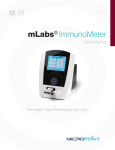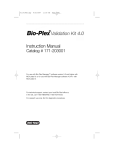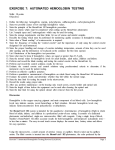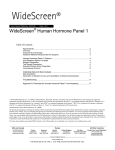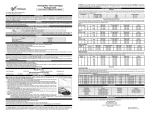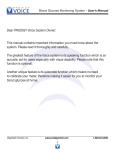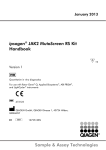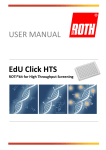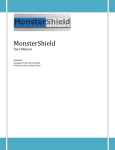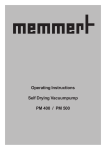Download Product Insert
Transcript
Materials Provided and Materials Needed But Not Provided Materials Provided Package Insert For in vitro diagnostic use CLIA Category - Waived INTENDED USE The Hgb Pro Professional Hemoglobin Testing System® consists of a portable, battery-operated meter and single-use test strips for the quantitative measurement of total hemoglobin from capillary and venous whole blood. The Hgb Pro Professional Hemoglobin Testing System is designed for near patient testing in a professional facility, and is not intended for home use. SUMMARY AND EXPLANATION Hemoglobin is the oxygen-carrying protein in red blood cells. The quantitative measurement of hemoglobin is indicated and clinically useful in acute illness as well as in general care. The normal range hemoglobin values as reported in medical literature1 are gender and age dependent: Adult males 13.5 – 18.0g/dL Adult females 12.0 – 16.0 g/dL Infants Ranging from 14.5 – 22.5 g/dL after birth to 11.1 – 14.1 g/dL at 6 months. Children Catalog No. HGBPROKIT: • Hgb Pro Meter • Hgb Pro User’s Manual • Hgb Pro Hemoglobin Test Strips • Hgb Pro Package Insert • Training CD ROM Materials Needed But Not Provided • • • • • Catalog No. HGBMETER: • Hgb Pro Meter • Hgb Pro User’s Manual • EZ Guide • Hgb Pro Hemoglobin • Hgb Pro Test Strips Meter • Test Strip Package • Hgb Pro Insert User’s Manual Liquid Quality Controls (see Section QUALITY CONTROL) Incision or fingerstick device Alcohol pad Gauze Bleach (for cleaning the meter) Step 1: Start the Meter Press the button to turn the meter on. The meter automatically monitors its internal circuitry and components during a brief self-check. The meter is ready when the test strip prompt, Lot Code, time and date are displayed. (Note: To conserve the battery, the meter will automatically shut off after 2 minutes of inactivity.) Step 2: Lot Code Entry A specific Lot Code is assigned to each lot of Hgb Pro hemoglobin test strips to ensure optimal lot-to-lot reproducibility. Check the Lot Code displayed on the meter to ensure it matches the Lot Code printed on the test strip container. Gradual change from infant to adult levels. Low hemoglobin levels may indicate conditions such as anemia or hemorrhage. Elevated hemoglobin levels may indicate conditions such as polycythemia. A hemoglobin test may be used as part of a general screen for many types of patient populations, including the elderly, children, and women of child-bearing age, and prior to giving or receiving transfusions. Due to differences among patient populations, we recommend that each clinical site establish its own expected ranges. Point-of-care test systems, using whole blood samples, are especially useful for rapid patient assessment and determination of further appropriate medical care. PRINCIPLE OF OPERATION The Hgb Pro meter utilizes optical reflectance at 522 nm for determination of total hemoglobin. This wavelength is within the known hemoglobin absorption spectrum (500 – 600 nm)2. The test strip is inserted into the meter when prompted. A background blank reading is automatically determined. A drop of whole blood is applied to the test spot on the strip. Blood immediately disperses within the membrane, contacting the reagent, lysing the red blood cells and releasing the hemoglobin. The meter’s optical detectors automatically measure the change in membrane reflectance. The intensity of reflectance is inversely proportional to the hemoglobin concentration. The meter calculates and displays the total hemoglobin concentration in grams/deciliter (g/dL) or millimole/liter (mmol/L) based on a mathematical conversion. The test result will be displayed in less than 30 seconds. REAGENTS Each container of Hgb Pro Test Strips contains: • 25 Test Strips Catalog No. HGBTEST100: • Hgb Pro Hemoglobin Test Strips • Hgb Pro Package Insert • EZ Guide Lot Code 453 If the Lot Code displayed on the meter does not match the Lot Code printed on the test strip container in use, change the Lot Code as follows: Step 1: Press and hold the ▼ button until CODE flashes in the upper left-hand corner. Release the ▼ button. Step 2: Press the ▲ or ▼ button so the displayed Lot Code matches the Lot Code printed on the test strip container in use. Holding down the button will enable the numbers to scroll faster. Release the button when the appropriate number is displayed. Step 3: Accept the new Code by pressing the button to turn the meter off. Step 4: Turn the meter on again to perform a test. Step 3: Prepare for a Fingerstick Make sure the patient’s hand is warm and relaxed. Use the middle or ring finger. Massage the patient’s finger from the knuckle up to the tip to stimulate blood flow. Clean the sample area with alcohol and wipe dry with a sterile gauze pad. The Hgb Pro Test Strip consists of a plastic carrier and a membrane preloaded with saponin, surfactant and colorant. The test strip container is stamped with a lotspecific Lot Code and expiration date. Note: The Lot Code for the lot number of test strips in use must be entered into the meter prior to use – see Lot Code Entry under TEST PROCEDURE in the Hgb Pro User’s Manual for instructions. CAUTION: Follow universal precautions and institutional guidelines for handling of blood samples, including the use of protective gloves. All used test strips should be considered potentially infectious, handled with care and disposed of using standard policies for disposal of medical waste. Reagent Preparation and Storage 1. Hgb Pro test strips are ready to use. No additional preparation is required. 2. Test strips are stable at ambient room temperature (15°C – 30°C) until the marked expiration date. Discard test strips that are past the marked expiration date. 3. Hgb Pro test strips are moisture sensitive. A dessicant is provided in the container lid. The remaining test strips should be resealed in their original container in order to retain the marked expiration dating. Remove only those strips needed for testing. Step 4: Prepare the Test Strip Remove a test strip from its container. Examine the strip: Do not use if there are tears, wrinkles or debris. Do not touch the test membrane. Reseal remaining strips in the original container. Step 5: Insert the Test Strip Insert the test strip into the strip holder with the notched end in first and the printing facing up. The blue stripe on the top of the strip should no longer be visible when the test strip is correctly and fully inserted. PRECAUTIONS 1. For in vitro diagnostic use. 2. The Hgb Pro test strips are designed for use only with Hgb Pro meter. 3. Poor blood collection technique and inadequate mixing of EDTA-treated samples may affect results. 4. As with all diagnostic tests, Hgb Pro test results should be evaluated with the specific patient’s condition. Any results demonstrating inconsistency with the patient’s clinical status should be repeated or supplemented with additional test data. 5. Review all instructions in the Hgb Pro User’s Manual for proper technique and procedure for performing tests and using the meter. Step 6: Prepare the Meter for Sample Application The meter will automatically perform a background blank reading. It will display a flashing prompt (a blood drop next to a test strip) to indicate it is ready to receive a sample. The meter will allow 2 minutes for application of the blood sample. 6. While the test is in progress, do not disturb or move the meter or test strip, or press any of the meter buttons. 7. The Hgb Pro System is designed for storage and operation within a recommended temperature range of 15°C to 30°C. Do not expose the meter, test strips or patient blood sample to temperature extremes, as such exposure could affect performance. OPERATING INSTRUCTIONS Before performing any test, the user should refer to the Hgb Pro hemoglobin meter User’s Manual for detailed instructions. SPECIMEN COLLECTION Fresh or EDTA-anticoagulated capillary or venous whole blood may be used. If an EDTA-treated sample is refrigerated, allow it to come to room temperature prior to use. EDTA-treated blood samples should be tested within 24 hours and thoroughly mixed, using end-to-end inversion at least 8 times prior to use. Hemolyzed blood samples should not be used. Anticoagulants other than EDTA are not recommended for use. Step 7: Perform a Fingerstick Incise the underside of the fingertip (as highlighted by arrow). Wipe away the first drop of blood. Apply light pressure to obtain another drop of blood. Avoid “milking.” Follow the Test Procedure section in this package insert for obtaining fingerstick samples. Refer to NCCLS Documents H4-A4, Procedures for the Collection of Diagnostic Blood Specimens by Skin Puncture3. For fresh whole blood venous samples, collect approximately 0.1cc into an anticoagulant-free plastic syringe, and apply a blood drop to the test spot from the syringe in place of steps 7 and 8 of the fingerstick procedure. Refer to NCCLS Document H3-A5, Procedure for the Collection of Diagnostic Blood Specimens by Venipuncture4. TEST PROCEDURE The user should review all instructions in the Hgb Pro User’s Manual prior to using the meter. Follow the instructions in SET-UP OPTIONS in the Hgb Pro User’s Manual for setting the time, date, and reporting units prior to the first use of the meter. See Product Use Tips under TROUBLESHOOTING in the Hgb Pro User’s Manual for more information on handling of the test strip and blood sample application. Note: If fresh venous whole blood is to be used, perform venipuncture and collect the sample in an anticoagulant free plastic syringe. Step 8: Apply Blood Sample to the Test Strip Immediately add a drop of blood to the test strip by touching the hanging blood drop to the test spot. (Make sure the blood drop is large enough to completely cover the test spot.) A capillary transfer pipet may also be used to transfer the blood sample from the finger to the test strip. Tips for applying a fingerstick blood sample to the meter: • A single blood drop of at least 15µl of blood must be applied. • DO NOT remove the test strip to apply the blood sample – the test strip must stay inserted in the meter. The meter may be lifted to the patient’s finger for blood application. • DO NOT touch the finger directly to the test spot membrane. • DO NOT overfill the test spot – add enough blood to completely fill the test spot only. • DO NOT add more blood once blood has already been applied to the test spot. Note: If a sample is obtained from a venipuncture, apply a blood drop (free of bubbles) to the test spot from the syringe opening or needle. Do not touch the syringe opening or needle directly onto the test spot. Step 9: Read Result The blood sample will spread and the meter will automatically begin the test. While the test is in progress, do not disturb or move the meter or test strip, or press any of the meter buttons. The result will be displayed as hemoglobin units (as defined in SET-UP OPTIONS in the User’s Manual) in either g/dL or mmol/L in less than 30 seconds. The test result will be displayed for 2 minutes after test completion. Accuracy The clinical performance of the Hgb Pro Professional Hemoglobin Testing System was evaluated with venous samples collected from 4 physician office sites and 1 hospital site, as shown in Figure 1. Populations consisted of adults, neonates and pediatric patients. Specimens were split for testing on the Hgb Pro and the Coulter MD8. Correlations for the individual populations and combined are shown: Figure 1 Adult Neonate Pediatric Neonate/Pediatric Combined n 162 26 38 64 226 Slope 1.049 0.984 0.962 0.988 1.005 Intercept -0.885 -0.156 0.042 -0.248 -0.371 r 0.982 0.987 0.944 0.988 0.985 LIMITATIONS 1. Plasma or serum cannot be used with the Hgb Pro Professional Hemoglobin Testing System. Use of arterial whole blood has not been evaluated. 2. Use of sodium citrate and dried heparin are not recommended. INTERFERING SUBSTANCES During clinical studies, a number of patients had identified elevated levels of bilirubin, cholesterol and triglycerides. The interferences of these substances were assessed using the interpretive guidelines of NCCLS Guidance Document EP7-A, Interference Testing in Clinical Chemistry: Approved Guideline7. There was no demonstrated interference of these substances on the hemoglobin determination in these analyses. No interference was observed at upper threshold concentrations of bilirubin 20 mg/dL, cholesterol 450 mg/dL and triglycerides 750 mg/dL in supportive laboratory "spiking studies.” QUALITY CONTROL A quality assurance program is recommended to assure the user of reliable performance of the Hgb Pro Professional Hemoglobin Testing System. Liquid quality control testing should be performed upon receipt of a new lot of test strips and once per every 3 months of test lot usage. After test is completed, remove the test strip and dispose according to standard methods for biohazard control. The meter will automatically shut off after 2 minutes of inactivity, or can be turned off by pressing the button. The test result will be stored automatically with its date and time stamp upon meter shutoff. The meter must be reset (shut off, restart) between each test. Test results can be tagged, viewed or erased. Follow instructions under TAG, VIEW AND ERASE TEST RESULTS in the Hgb Pro User’s Manual. REPORTABLE RANGE The reportable range for the Hgb Pro Professional Hemoglobin Testing System is from 4.0 g/dL to 24.0 g/dL. Results under 4.0 g/dL and over 24.0 g/dL will be displayed as “Lo” and “Hi” respectively to indicate out of range results. PERFORMANCE CHARACTERISTICS Linearity The linearity of the Hgb Pro System was tested using one lot of Hgb Pro strips and 7 hemoglobin concentrations prepared from a single normal donor. Multiple Hgb Pro instruments (n=5) were tested twice at each concentration. The data were analyzed using the NCCLS guideline EP6-A "Evaluation of the Linearity of Quantitative Analytical Methods"5. The Hgb Pro Hemoglobin Testing System is linear between 4.0 g/dL to 24.0 g/dL within 5% of the estimated linear regression line at a 95% confidence level. The linearity regression curve is: Y=0.974x+0.264, r=0.99. Commercially available control material can be used for this purpose. The Streck Laboratories® PARA 4® Hematology Control is recommended (phone 800-8430912 or website www.streck.com). The Streck PARA 4 Hematology Control product (catalog # 215110) consists of Normal, Low Abnormal and High Abnormal levels. Storage requirements, expiration dating and acceptable performance ranges for the control material with the Hgb Pro meter should be obtained from this product’s package insert. Instructions for use of the Para 4 Control are as follows: Step 1: Allow the PARA 4 control vials to come to room temperature prior to use. Prepare the meter and test strip as instructed in Steps 1, 2, 4 and 5 under TEST PROCEDURE above. Step 2: Mix the vial using end-to-end inversion until the red blood cells are completely suspended. Do not shake or mix mechanically. Step3: Remove the vial cap and discard the first drop of the control material. Apply one drop of control material; make sure the test spot is completely filled (do not touch the test spot membrane with the vial tip). The test will begin automatically. Step 4: The Hgb Pro meter will display the result upon test completion. Compare the displayed result to the range indicated on the PARA 4 package insert. Record result. Note: Streck control ranges are provided in g/dL. The g/dL unit can be converted to mmol/L by dividing the g/dL value by 6.45. REFERENCES Precision studies The total precision of the Hgb Pro Professional Hemoglobin Testing System was calculated from testing of commercial controls on multiple days. The Hgb Pro System was tested repeatedly for 20 days with commercially available controls as per NCCLS Document EP5-A6. The testing for the protocol evaluated three levels of commercial controls in four (4) instruments with two lots of Hgb strips. The data in Table 1 was obtained for within run and total precision of the Hgb Pro System. Table 1 Precision Mean SD %CV Level I (n=80) Within Total 6.86 6.86 0.17 0.18 2.41 2.66 Level II Within 11.33 0.20 1.73 (n=80) Level III Total Within 11.33 15.63 0.25 0.18 2.17 1.14 (n=80) Total 15.63 0.29 1.86 Additionally, precision of the Hgb Pro system was calculated from testing of freshly prepared whole blood controls created to specified hemoglobin concentrations. Samples were prepared from normal donor blood hemodiluted or hemoconcentrated to manipulate hemoglobin concentration. Multiple Hgb Pro instruments were tested repeatedly for 3 days. The hemoglobin levels of the daily-prepared controls were confirmed with the Coulter Laboratory instrument (Beckman Coulter, Fullerton, CA) and are shown in Table 2 as “Range.” Three levels of venous whole blood samples were tested with 5 instruments each day. Over the 3 days, a total of 9 instruments and 3 unique lots of strips were evaluated. Precision across strip lots, instruments and days is shown in Table 2. Table 2 Range Mean SD %CV N Level I 6.0 - 6.4 6.30 0.14 2.25 87 Level II 13.0 - 13.4 13.44 0.32 2.35 90 Level III 19.4 - 19.9 19.88 0.39 1.97 90 1. Vengelen-Tyler, V. ed. Technical Manual, 13th Ed. Bethesda, MD: American Association of Blood Banks. 1999: 753-754. 2. Neuberger, A. and E.L. Tatum, Ed. Frontiers of Biology, North-Holland Publishing Co. 1970, p.18. Hemoglobin and Myoglobin in their Reactions with Ligands, Antoini, E. and M. Brunori. 3. NCCLS Document H4-A4, Procedures for the Collection of Diagnostic Blood Specimens by Skin Puncture. 4. NCCLS Document H3-A5, Procedure for the Collection of Diagnostic Blood Specimens by Venipuncture. 5. NCCLS Document EP6-A, Evaluation of the Linearity of Quantitative Measurement Procedures: A Statistical Approach. 6. NCCLS Document EP5-A, Evaluation of Precision Performance of Clinical Chemistry Devices. 7. NCCLS Document EP7-A, Interference Testing in Clinical Chemistry.




